Owen Jones (1809-1874)
Owen Jones (1809-1874) was a Welsh architect and interior designer who designed the backs of playing cards for Thomas de la Rue.
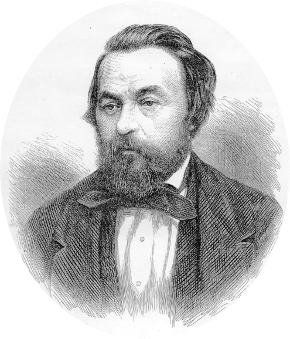
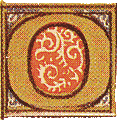
wen Jones (1809-1874), the son of a Welsh antiquary, was an architect and interior designer. He studied with the architect Lewis Vulliamy (1791-1871) and then entered the Royal Academy schools. After a European tour which led him to sketch and paint the Alhambra, the Moorish palace at Granada, his attempts to get these lithographed led him to set up a printing establishment. Apart from the Plans, Elevations, Sections and Details of the Alhambra (1836), which was the first English chromo-lithographed work, Jones is best known for his Grammar of Ornament (1856) which came to be regarded as a masterpiece, but he specialised as a colour printer in the illuminated gift book beloved by the Victorians.
Owen Jones started working for Thomas De La Rue in 1844, who was at that time keen to have the best artists working for him. In the ensuing twenty years Jones created 173 different playing card designs varying from fruit-and-flower themes to Chinese and Arabesque. Owen Jones played a prominent part in the lives of three generations of De La Rues - Thomas, assisting Warren and William Frederick, and finally Warren's son, the eccentric Warren William, who was sent to him to learn lithography. Owen Jones was appointed superintendent of works for the 1851 Crystal Palace Exhibition and took an active part in decorating and arranging the building. Louis Cohen, who founded New York playing card maker Lawrence & Cohen, also shared the services of Owen Jones, whose name appeared on their ace of spades in c.1865.
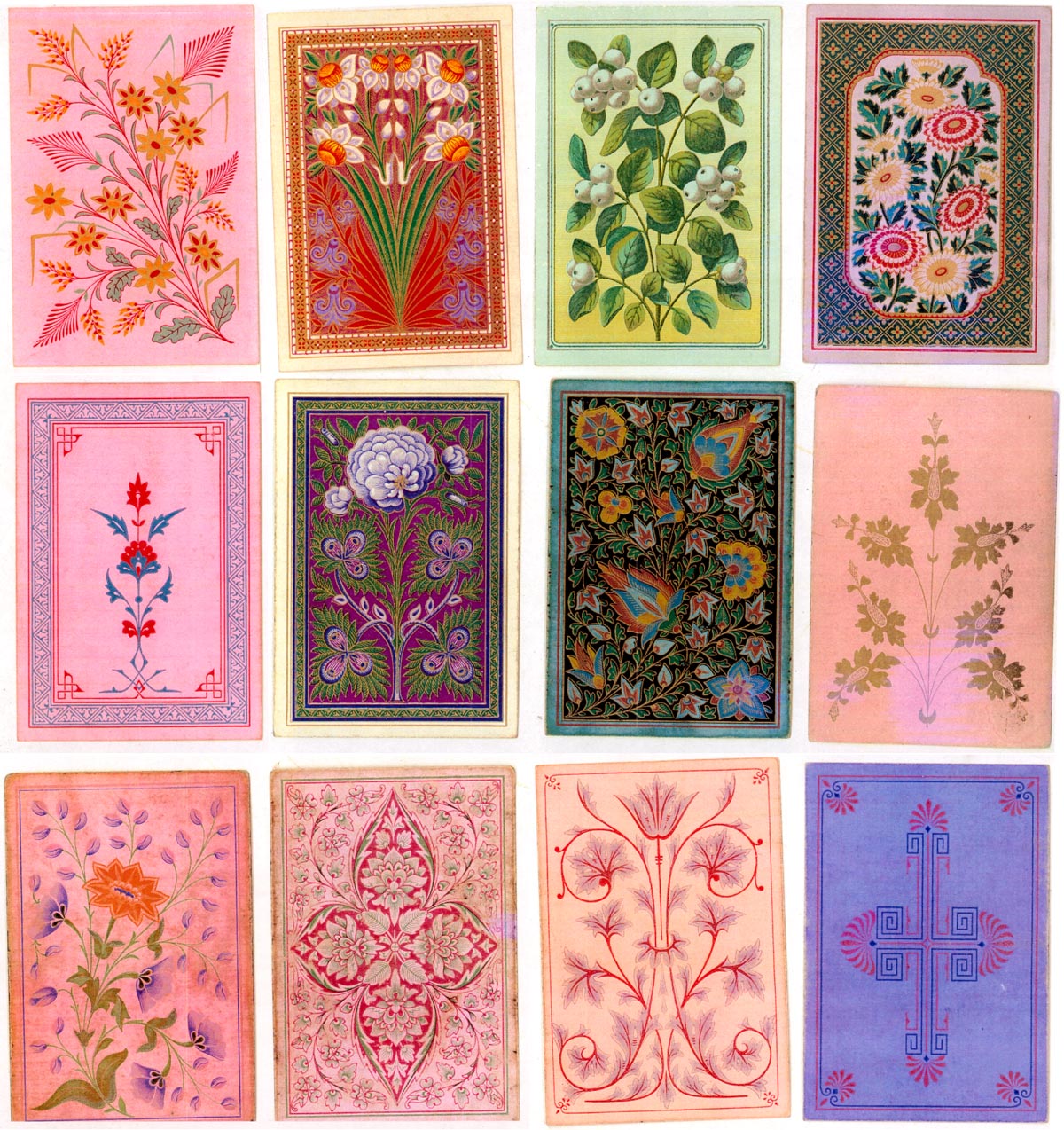
Above: eight playing card back designs by Owen Jones. Jones advocated a strong design philosophy with an underlying sense of the unity between art and culture. He realised that many of the great masterpieces from antiquity, including Moorish art, were based on geometrical grid patterns embellished with graceful and refined arabesques.
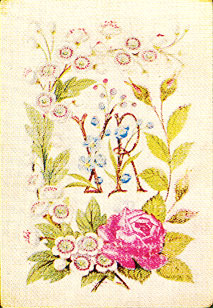 |
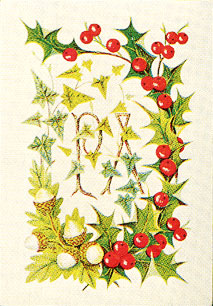 |
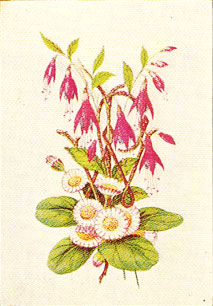 |
Above: three backs from the Royal Illuminated Playing Cards, c.1850. Charles Dickens was delighted with the 'poetry of card-making', the 'graceful designs' and 'dainty little pictures' by Owen Jones which appeared on the firm's playing cards for members of the Royal family. Jones-designed cards were expensive. De La Rue advertised the 'Royal Illuminated Playing Cards' in an 1851 Illustrated London News at 'Two Guineas the Set of four patterns or singly 10s 6d the pack'. This was, of course, extremely expensive. The Queen's design depicts roses and hawthorn. Prince Albert's consist of prickly holly, ivy and oak. The Prince of Wales' design depicts daisies and fuchsias.
Owen Jones was a member of the circle of people around Henry Cole who was aiming at higher standards in the Art Manufactures and whose ideas later influenced William Morris. In later life he decorated private houses including the Palace of the Viceroy of Egypt. He exhibited architectural designs at the Royal Academy between 1831 and 1861, and he also designed wallpaper, textiles and carpets. He died in 1874 aged 65 at his home in Argyll Place, Regent Street, London.
For further reading see: Michael Cooper & Ken Lodge, "Owen Jones (1809-1874): Architect, Decorative Artist & Designer of Playing Cards" in 'The Playing Card', Journal of The International Playing Card Society, Vol.34, No.3, Jan-March 2006, pp.181-192. Also: The Newsletter of The English Playing Card Society, No.10, November 1985, pp.8-9.

By Simon Wintle
Member since February 01, 1996
I am the founder of The World of Playing Cards (est. 1996), a website dedicated to the history, artistry and cultural significance of playing cards and tarot. Over the years I have researched various areas of the subject, acquired and traded collections and contributed as a committee member of the IPCS and graphics editor of The Playing-Card journal. Having lived in Chile, England, Wales, and now Spain, these experiences have shaped my work and passion for playing cards. Amongst my achievements is producing a limited-edition replica of a 17th-century English pack using woodblocks and stencils—a labour of love. Today, the World of Playing Cards is a global collaborative project, with my son Adam serving as the technical driving force behind its development. His innovative efforts have helped shape the site into the thriving hub it is today. You are warmly invited to become a contributor and share your enthusiasm.
Related Articles

Boddingtons Bitter playing cards
Cool-looking courts advertising Boddingtons Bitter, originally brewed in Manchester.

OXO Faces of the Millennium Dinner
Twentieth-century personalities promoting a millennium dinner at the Oxo Tower in London.

Modern Swiss-German Pattern (carta.media)
Modernizing tradition: balancing clarity and continuity in regional card design.

Kids Fun Box playing cards
Colourful cards for children with four non-standard suits connected with the natural world.

Tangle Foot Ale
Badger Brewery Tangle Foot strong ale advertising pack.

Tactics Design
Late modernist Japanese playing cards designed by Masayoshi Nakajo for Tactics Design.

Scientific Whist
“Scientific Whist” : standard cards with instructions for play on the faces by Chas Goodall & Son, 1...

Agent Provocateur
Branded lingerie collection in a pack of pin-up playing cards.

Nimbus playing cards
Mike Steer’s weather-themed pack with suits in four colours and backs for cardistry.

Agatha Christie and Playing Cards revisited
Agatha Christie uses card-play as a primary focus of a story, and as a way of creating plots and mot...

The Decadent Deck
Studies in the eroticism of the female body by Inge Clayton.

Historic Shakespeare
“Historic Shakespeare” playing cards featuring Shakespearean characters by Chas Goodall & Son.

Sunday Night / Nichiyoubi no Yoru
An irreverent, avant-garde deck unofficially titled "Nichiyoubi no Yoru" (Sunday Night), designed by...

Copechat Paramount Sorting System
Preserving the past: a specimen deck showcasing edge-notched cards and their ingenious sorting syste...

Heartsette by Herbert Fitch & Co, 1893
A glimpse into a busy print and design office in late Victorian London.

Emilio Tadini playing cards
Beautiful dreamlike playing card designs by Emilio Tadini.
Most Popular
Our top articles from the past 28 days


